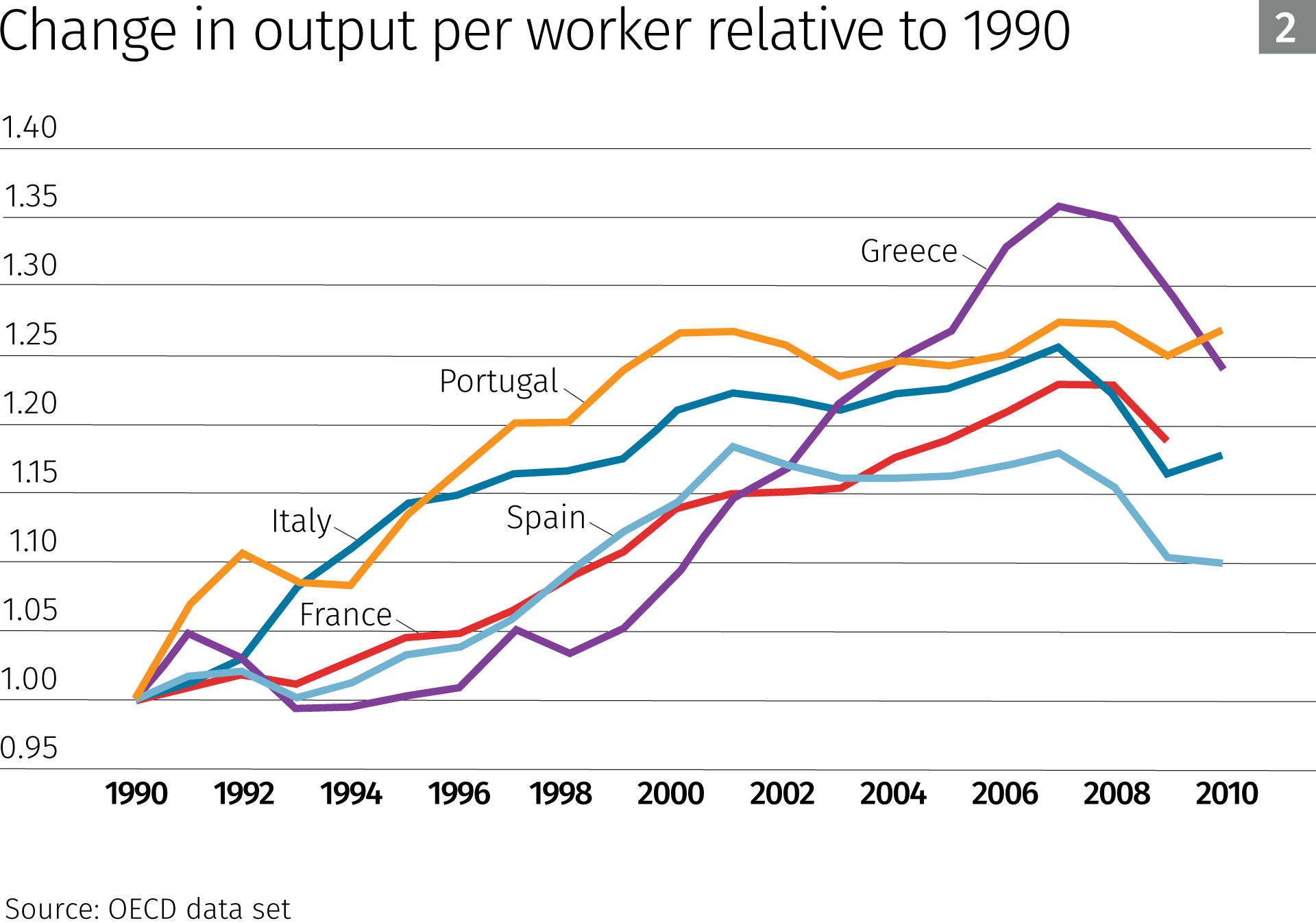Economic Policy Papers are based on policy-oriented research produced by Minneapolis Fed staff and consultants. The papers are an occasional series for a general audience. The views expressed here are those of the authors, not necessarily those of others in the Federal Reserve System.
Executive Summary
In this paper, we discuss conditions under which adverse expectations can trigger abrupt and large changes in the interest rate at which a sovereign country can borrow in international financial markets. We argue that such changes are caused by self-fulfilling expectations outcomes, in which interest rates are high because the perceptions of future defaults are high, but those perceptions are high precisely because the interest rates are high.
A model based on these elements successfully simulates the near-default experience of Greece, Italy, Spain and Portugal, among other countries. We show that self-fulfilling traps can occur when two conditions are met: First, the existing level of government debt must be relatively high; second, the probability that the country faces a long period of economic stagnation must be substantial.
We also show that if a sufficiently large institution is willing to lend to the country, these self-fulfilling traps can be eliminated. Our model thus suggests that the Outright Monetary Transactions (OMT) program adopted by the European Central Bank in the summer of 2012 saved southern European countries from a massive sovereign debt crisis.
Introduction
What causes nations to default on bonds they issue, an international crisis that occurs with remarkable frequency? The sources of sovereign default are many, certainly, and bad economic fundamentals—imprudent fiscal policies and tepid growth, for example—are central.
But an often-overlooked factor is the role of expectations. Lenders will require higher interest rates when they consider a nation’s fundamentals to be high risk and expect that it may be unable to repay its debts. That is, expectations that a nation may default, due in part to high debt levels, can provoke lenders to raise interest rates on sovereign bonds. But high interest rates themselves raise debt levels. Thus, the interplay between fundamentals and expectations can establish a vicious circle of self-fulfilling prophecy: sovereign default triggered by belief that default is probable.
This policy paper reports on recent research into the interplay between expectations and fundamentals in causing sovereign default. It uses a model built around both elements to explore their explanatory power and finds that, indeed, such a model can help to explain large and abrupt increases in interest rates on government bonds during sovereign debt crises, particularly in countries that have accumulated large debt levels. The research then applies the model in the context of the recent European default crises and the policy response of the European Central Bank, suggesting that the ECB’s policy can be credited for quickly reducing sovereign interest rates and thereby reducing the likelihood of default.
Background
Bonds issued by government—so-called sovereign bonds—are special in the sense that no collateral is pledged to the lender and no international courts can enforce the debt contract between lender and government. The interest rate charged depends on market expectations regarding the ability and willingness of future governments of the bond-issuing country to repay the debt. Lenders logically demand higher returns for these unsecured, unenforceable loans, so interest rates charged on sovereign bonds are typically higher than risk-free bonds issued by the United States or Germany. This rate difference is referred to as the “default premium” or “default spread.”
Naturally, the premium increases when the perceived probability of default increases, and this probability rises in proportion to the total value of the debt (that is, larger loan amounts have a greater risk of not being paid back). Because debt accumulates faster when the interest rate charged on it is higher, it therefore follows that default probability rises in direct relation to the interest rate and the loan amount.
These effects can combine themselves in an explosive vicious circle and create a self-fulfilling prophecy in which the interest rate is high because default probability is high, but default probability itself is high because the interest rate is high. This is the theme of a seminal contribution by Guillermo Calvo.1
In recent research, we refine and apply Calvo’s notion in an analysis of the European sovereign debt crisis that begin in 2010.2 The spreads on Italian and Spanish public debt, depicted in Figure 1, were very close to zero from the introduction of the euro in the early 2000s until the financial crisis in 2008. Rates rose at that point but remained below 1 percent until 2010. Rates then climbed rapidly, exceeding 5 percent by the summer of 2012. Servicing the resulting debt became an immense fiscal hardship for both nations, leading to chains of threatened and actual sovereign default.

What changed between 2010 and 2012? In terms of economic fundamentals, not much. Instead, our analysis suggests, the large and abrupt movements in interest rates observed in this and other sovereign debt crises resulted from a perverse interaction between default expectations and interest rates faced by debt-troubled countries. Our work indicates that with long-term debt, two factors make self-fulfilling default highly likely: First, as argued above, the total value of debt; second, the prospect of economic stagnation. The expectation of a long period of economic stagnation is key because an obvious way to solve a sovereign debt crisis is to grow out of it, thereby raising income available to service debt.3
Was Greece over-borrowing from 1997 to 2007? In hindsight, this question seems ludicrous: Given its economic performance over the last six years, it is now obvious that Greece was borrowing far beyond its capacity to repay.
At the time, however, Greece’s economy seemed quite healthy: Its output grew by 40 percent during that decade. Was it reasonable to expect that Greece could keep that pace for another couple of decades? Again, at that time, most economists believed it was reasonable, given the experience of other countries joining the European Union and taking into account that its GDP was still only 65 percent that of Germany (suggesting that continued fast growth was entirely possible).
The Greek experience differs from those of Italy, Spain and Portugal, but those countries also endured long periods of stagnation, alternating with relatively long periods of healthier growth rates.
Figure 2 plots output per worker for Spain, Portugal, Italy, Greece and France from 1990 to 2010, with each performance depicted relative to its 1990 value. France exhibits steady growth for the entire period. In contrast, Spain, Italy and Portugal exhibit rapid growth for the first decade or so and a period of stagnation until the 2009 crisis hit all nations. As discussed, Greece starts growing during the mid-’90s and grows very rapidly until 2007, without the stagnation seen in Spain, Portugal and Italy.4

Our interpretation of the European debt crisis is the following. During the first years of this century, there was a prolonged period of relatively solid growth and low volatility in developed economies. There was little reason to believe that this would abruptly stop. When the 2007-2008 international financial crisis hit, most developed countries were convinced that the problem was a temporary lack of demand. They therefore followed extremely expansionary fiscal policies, running very large deficits, and increased their debt. Indeed, debt accumulation between 2009 and 2011 ranged from 72 percent to 108 percent for Portugal, 40 percent to 70 percent for Spain and 106 percent to 120 percent for Italy. At the low prevailing interest rates, however, there was no reason to believe default was a serious risk.
By 2010, though, it became clear that what had initially been a crisis originating in the United States had expanded to Europe and that it would be more permanent than initially thought. Thus, the two seeds required to generate a pessimistic outcome for Europe—high total value of debt and the prospect of economic stagnation—had been planted together. Spreads started to grow through the summer of 2012, going above 5 percent for Italy and Spain, as in Figure 1.
The role for policy
Is there any conceivable policy that can rule out the equilibrium driven just by pessimistic expectations of investors? Yes. Our model argues that if a sufficiently large financial institution announces its willingness to lend to the country, the prospect of default will disappear. The policy adopted by the European Central Bank in September 2012, following ECB president Mario Draghi’s famous “We will do whatever it takes to save the euro” speech, was a vivid real-life example.
To understand the role for policy, it is important to review the logic of the self-fulfilling outcome. According to our theory, every investor understands that by requiring a high interest rate, the market is increasing the probability that the country will default. But there is a coordination problem: The rate required by each investor depends on the rate charged by others. To burst the expectations-driven pessimistic equilibrium of default, an institution with sufficient financial resources is needed. Offering to buy bonds at an interest rate that is lower than the pessimistic equilibrium does so, thereby coordinating investor expectations. The pessimistic equilibrium of massive default is eliminated. Furthermore, the large agent does not actually buy any bonds: A credible promise to do so is enough.
The OMT policy announced by the ECB in September 2012 amounted to buying bonds of the government under conditions of severe market distress. The measure specified that it would buy sovereign bonds at “market prices,” so it did not directly address the problem of the pessimistic expectations as required by our theory. However, in his speech, Draghi did explicitly mention the need to use policy to rule out the speculative equilibrium. As can be seen in Figure 1, where the vertical line indicates the week of the OMT announcement, spreads went down systematically to levels in 2014 very similar to those of 2009. The OMT was never actually put into practice. Again, the ECB did not need to buy any bonds: The promise was sufficient.
Appendix
The future of the euro
The decision of the ECB was challenged by the German Constitutional Court in January 2014, claiming that the ECB had overstepped its mandate and that the OMT opened the door for monetary financing of the deficits. At the same time, it referred some crucial points to the European Court of Justice, which, in June 2015, ruled strongly in favor of the ECB. Our paper is consistent with the view taken by the European Court, since ruling out a speculative equilibrium is not money financing of the deficits.
What are prospects for the next few years? In spite of the austerity policies, government debts have been increasing to very high levels. Recent elections in Portugal and Spain showed the political difficulties of maintaining austerity policies. In addition, the persistency of stagnation is so remarkable that the discussion of “secular stagnation” has totally replaced the analysis of the Great Moderation that prevailed during the first years of the 21st century. A very modest improvement in the European economy is the only, but insufficient, cause for moderate optimism and implementing growth-promoting policies would help considerably, if we just knew what they are!
Thus, the seeds for a pessimistic outcome are still with us.
Endnotes
1 See Calvo 1988.
2 See Ayres et al. 2015 and Lorenzoni and Werning 2013.
3 A very heated debate has dominated European policy circles, between those that propose growth promoting policies on one hand and those that propose austerity measures on the other. A problem with the first proposal, however, is the lack of consensus on what those policies actually are: If we knew how to make economies grow, we would have done it long ago.
4 This sequence of long “fat cow” periods followed by equally long “thin cow” periods dating back to the book of Genesis in the Bible has actually been documented in academic papers.
References
Ayres, João Luiz, Gaston Navarro, Juan Pablo Nicolini and Pedro Teles. 2015. Sovereign Default: The Role of Expectations. Working Paper 723. Federal Reserve Bank of Minneapolis.
Calvo, Guillermo A. 1988. Servicing the Public Debt: The Role of Expectations. American Economic Review 78 (4): 647-61.
Lorenzoni, Guido, and Ivan Werning. Slow Moving Debt Crises. Working Paper 19228. National Bureau of Economic Research.





